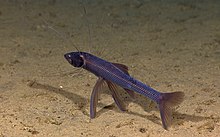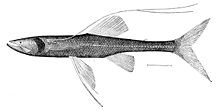ar
الأسماء في صفحات التنقل


Bathypterois is a genus of deepsea tripod fishes. They are a diverse genus that belong to the greater family Ipnopidae and order Aulopiformes. They are distinguished by having two elongated pelvic fins and an elongated caudal fin, which allow them to move and stand on the ocean floor, much like a tripod, hence the common name.[2] Bathypterois are distributed worldwide with some particular species of the genus having specialized environmental niches, such as lower dissolved oxygen concentrations.[3] Bathypterois have a reduced eye size, highly specified extended fins, and a mouth adapted to filter feeding.[2] They are filter feeders whose main food source is benthopelagic planktonic calanoid copepods, but some variation is seen with maturity in secondary food sources.[4] Bathypterois use their three elongated fins for a wide range of motion from landing to standing on the ocean floor to catching prey, for which these fins serve as specialized perceptory organs.[2] Bathypterois have both male and female gonads at once making, them simultaneous hermaphrodites, whose gonads go through five stages of development following seasonal autumn spawning.[5]
There are 19 different species within Bathypterois that are spread around the world.[6] Six of these belong to the subgenus Bathycygnus.[7] The taxa Bathypterois was first named and identified in 1878 by German zoologist Albert Günther. The newest addition, Bathypterois andriashevi, was named and identified in 1988 by Kenneth Sulak and Yuri Shcherbachev.[7] Species are most effectively distinguished by characteristics such as dorsal, caudal and pectoral fin patterns, scale patterns, and where they most often occur both ecologically and geographically.[7][3]
The 19 recognized species in this genus are:[8]
The niches the different species within Bathypterois live in vary and can be as deep as 6,000 m in and in both temperate or tropical oceans.[6] Some species, such as Bathypterois ventralis, are known to prefer warmer waters and lower dissolved oxygen concentrations/oxygen deficient zones, which they are well adapted for.[3] Certain species, such as Bathypterois filiferus are endemic to the southern Pacific and northern Indian oceans, while others such as Bathypterois longipes, are endemic to the mid/southern Atlantic.[7] Some species prefer the continental slope while others prefer the depth of the abyssopelagic.[7] However, in general, Bathypterois has a very broad distribution with much overlap between environments since they are so well adapted to survival in a variety of niches.[3]

Bathypterois are typically around 30 cm in size but have been observed as large as 43.4 cm in size.[8] Their eyes tend to be small in size.[2] The coloring of the genus varies from colorless to black as well as uniform to multicolored among the different species within the genus.[7] Bathypterois tend to have non-sensory pads at the end of extended pelvic and caudal fin ray elements.[2] These extended elements can extend to up to three times that of the body, or around 1 meter.[10] The pads allow the rays to rest on the sea floor creating the sedentary three point (tripod) stance that is typically observed of Bathypterois.[2] The pectoral fins are also extended, and are sensitive to sensory input as a result of the spinal nerves having three innervations and being enlarged in the pectoral fins of most Bathypterois species.[2] They have two gonads, one male and one female. The male testicular gonad is more dorsal than the female ovarian gonad.[11] Both gonads work, meaning they are able to produce sperm or eggs respectively, and are clearly unique from the other.[5] Their mouth is large and upturned and contains little dentition.[2] The laminar gill rakers are long, thin, and covered in small spines.[2][4] They tend to have stomachs that are linear and poorly differentiated.[4]

Bathypterois have two main pelvic fins and caudal fin that serve a variety of purposes, from perching and walking on the seafloor, to swimming and landing, to sensing and capturing prey.[2] When perching/landing the pelvic fins, they act as "stilts", while the third caudal fin then closes the tripod and allows for stability.[2] Bathypterois are predominantly observed with their body positioned upstream, facing the current in order to wait for prey and conserve energy.[12] Their swimming is described as intervallic and "subcarangiform", meaning fins and body are used in addition to the tail.[2] These fins also play a very important role in hunting technique--they are used, in essence, as hands. Due to both poor eyesight and a lack of light at abyssal depths, Bathypterois use their pelvic fins to orient themselves as well as to sense and seize prey around them.[13][2]
What they feed on changes based on maturity, however they are always filter feeders. In order to feed, they have laminar gill rakers that are long and thin that allow them to capture planktonic prey.[4] They face into the current in the tripod stance allowing the food to come to them.[10] The main food source for them is benthopelagic planktonic calanoid copepods, no matter the depth and maturity. However, between 1800 meters and 2250 meters the secondary prey is different for juvenile and mature Bathypterois.[4] Both mature and juvenile organisms diet increases to include endobenthic and epibenthic prey as the secondary food source, which for juveniles is benthic tanaidaceans and for mature Bathypterois is mysids.[4][13] The difference in diet between juvenile and mature organisms is not big but does vary across the different species.[13] It has been indicated that the species Bathypterois grallator eats larger, gelatinous prey as well as the other common food sources for species within the genus.[2]
Bathypterois is a genus of simultaneously hermaphroditic species. They will only give birth/reproduce once a year as a result of monocyclic ovaries.[11] There are five stages to the development and maturation of the gonads, which are immature, developing, maturing, mature, and post-spawning. These developmental stages include both macroscopic and microscopic changes, as well as growth until the gonads are flaccid in the last stage. The gonads go from two colorless filaments (immature), to being a pinkish white (developing), to pink with eggs visible under a stereomicroscope (maturing), to orange with eggs visible to the eye (mature), and finally to reddish with little visible eggs (post-spawning).[5] Spawning is thought to occur in late September through early November and the next egg won't develop until after a short rest period.[11] The maturity is thought to peak around April but can be seen from March to November for both male and female gonads. Indicating seasonal autumn spawning within Bathypterois.[5] They are able to mate with other fish of their species, or they can fertilize themselves, since they have the two different gonads. Self fertilization occurs and the fish excretes both sperm and egg into the water, but when mating with another fish they each only excrete one.[10]
 Bathypterois dubius
Bathypterois dubius Bathypterois is a genus of deepsea tripod fishes. They are a diverse genus that belong to the greater family Ipnopidae and order Aulopiformes. They are distinguished by having two elongated pelvic fins and an elongated caudal fin, which allow them to move and stand on the ocean floor, much like a tripod, hence the common name. Bathypterois are distributed worldwide with some particular species of the genus having specialized environmental niches, such as lower dissolved oxygen concentrations. Bathypterois have a reduced eye size, highly specified extended fins, and a mouth adapted to filter feeding. They are filter feeders whose main food source is benthopelagic planktonic calanoid copepods, but some variation is seen with maturity in secondary food sources. Bathypterois use their three elongated fins for a wide range of motion from landing to standing on the ocean floor to catching prey, for which these fins serve as specialized perceptory organs. Bathypterois have both male and female gonads at once making, them simultaneous hermaphrodites, whose gonads go through five stages of development following seasonal autumn spawning.
 Abyssal spiderfish, B. longipes
Abyssal spiderfish, B. longipes  B. quadrifilis
B. quadrifilis
Bathypterois es un género de peces aulopiformes de la familia Ipnopidae.
Se han descrito 19 especies de este género:[1]
Bathypterois es un género de peces aulopiformes de la familia Ipnopidae.
Bathypterois, parfois dénommé poisson trépied ou poisson tripode, et parfois encore, à tort, Benthosaurus, est un genre de poisson de la famille des Ipnopidae.
Lorsqu'il est pêché pour la première fois, au début du XXe siècle, on croit que ses rayons très allongés servent à détecter les mouvements émis par ses éventuelles proies[réf. nécessaire]. Il faut attendre que le Commandant Houot descende à 2 400 mètres de profondeur pour observer et photographier ce curieux poisson[réf. nécessaire]. Ses rayons allongés ne servent pas à détecter la nourriture, mais bien à se tenir dessus, comme un échassier se tient sur des échasses[réf. nécessaire]. Au lieu de profiter le la longueur de son corps pour se mouvoir rapidement, il préfère « s'asseoir » et attendre[réf. nécessaire].
Selon FishBase (2 avril 2017)[1], Catalogue of Life (28 juin 2012)[2], World Register of Marine Species (28 juin 2012)[3] et ITIS (28 juin 2012)[4] :
Bathypterois, parfois dénommé poisson trépied ou poisson tripode, et parfois encore, à tort, Benthosaurus, est un genre de poisson de la famille des Ipnopidae.
Bathypterois è un genere di pesci ossei abissali appartenente alla famiglia Ipnopidae.
Il genere si trova in tutti i mari e gli oceani. Nel mar Mediterraneo è presente B. dubius, molto raro, e B. grallator, la cui presenza in questo mare è addirittura messa in dubbio dagli ittiologi[1]. Si trovano esclusivamente nel piano abissale.
Bathypterois è un genere di pesci ossei abissali appartenente alla famiglia Ipnopidae.
Bathypterois is een geslacht van straalvinnige vissen uit de familie van netoogvissen (Ipnopidae).[1] Het geslacht is voor het eerst wetenschappelijk beschreven in door Guenther.
Bathypterois is een geslacht van straalvinnige vissen uit de familie van netoogvissen (Ipnopidae). Het geslacht is voor het eerst wetenschappelijk beschreven in door Guenther.
Bathypterois – rodzaj ryb skrzelokształtnych z rodziny Ipnopidae. W języku polskim określane są nazwą bentozaury od synonimicznej nazwy Benthosaurus, pod którą były opisywane[3]. Są przystosowane do życia na dużych głębokościach. Mają wydłużoną głowę z dużym otworem gębowym, szczątkowe oczy oraz wydłużone zewnętrzne promienie płetw brzusznych i dolne promienie płetwy ogonowej. Te wydłużone promienie są wykorzystywane do podpierania ciała ryby o dno oceanu, w oczekiwaniu na zdobycz.
Gatunki zaliczane do tego rodzaju [4]:
Bathypterois – rodzaj ryb skrzelokształtnych z rodziny Ipnopidae. W języku polskim określane są nazwą bentozaury od synonimicznej nazwy Benthosaurus, pod którą były opisywane. Są przystosowane do życia na dużych głębokościach. Mają wydłużoną głowę z dużym otworem gębowym, szczątkowe oczy oraz wydłużone zewnętrzne promienie płetw brzusznych i dolne promienie płetwy ogonowej. Te wydłużone promienie są wykorzystywane do podpierania ciała ryby o dno oceanu, w oczekiwaniu na zdobycz.
Bathypterois là một chi cá trong họ Ipnopidae.
Có 19 loài được ghi nhận:[1]